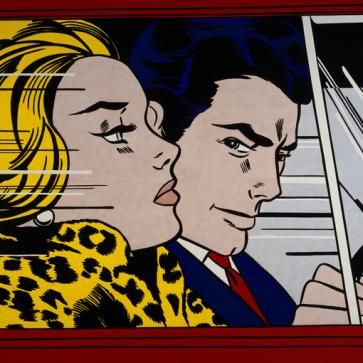An art movement of the 1970s and 80s inspired by German Expressionism. Most popular in Germany and America, the style is characterized by large, figurative works, rapidly painted, often with objects, such as broken plates or straw, incorporated into their surfaces.
The origins of Neo Expressionism
Neo Expressionism emerged in 1970s and is now seen as a strand of Postmodernism. Artists associated with the movement rejected the sparseness of Minimalism, Conceptual Art and the International Style, choosing instead to flood their work with sensuous subjects including narrative, mythology, memory and psychology. The style is characterised by tactile, raw handling of materials and a vibrant expression of emotions, particularly through large scale painting. A number of survey exhibitions including A New Spirit in Painting, in London and Zeitgeist in Berlin helped resurrect a new interest in painting.
Influences
Influences on Neo Expressionism are diverse, including Expressionism, Post-Impressionism, Surrealism, Abstract Expressionism, Art Informel and Pop Art. The often complex layering of sources and styles were typical of Postmodernist thought that was becoming internationally popular in the 1970s and 80s. In Germany, the Expressionists from the early twentieth century were particularly influential, with more contemporary artists reaching greater levels of expression and abstraction than their counterparts. Georg Baselitz instigated the movement in Germany as early as 1963, when he opened a controversial exhibition in West Germany featuring explicit male imagery.
By the 1970s Baselitz had spearheaded a group known as Neue Wilden (the New Fauves), along with Anselm Kiefer, Markus Lupertz, Eugen Schonebeck and A.R. Penck. Kiefer’s dark, unsettling imagery and richly textured surfaces layered with straw, tar and sand addressed Germany’s complex and troubled Post-War identity. Other artists associated with the style in Germany include Sigmar Polke and Gerhard Richter, who have both continued to create richly layered, conceptual paintings in multiple styles.
Neo Expressionism in the United States
Expressive art was also experiencing a surge of popularity in the United States of America. Philip Guston is seen as a precursor to the style, who rejected an abstract style of painting in favour of roughly executed figurative subject matter loaded with political content. He famously said, ‘I got sick and tired of all that purity … (I) wanted to tell stories.’ The 1970s trend emerging in New York known as New Image Painting also proved influential. Much like Pop artists of the 1960s, American Neo Expressionists found ways of incorporating imagery that reflected American society, such as Julian Schnabel, who straddled the boundaries between painting and sculpture by incorporating found objects onto his canvases as diverse as rugs, wood and broken plates.
In the United Kingdom, The School of London preceded painterly developments, with Francis Bacon now claimed as a predecessor to artists such as Jenny Saville, whose Rubanesque nudes continue to celebrate expressive language and the female form.
















